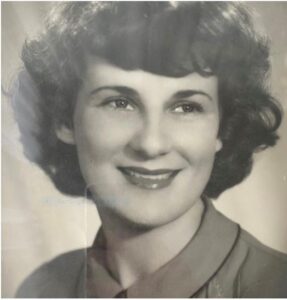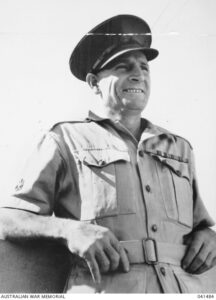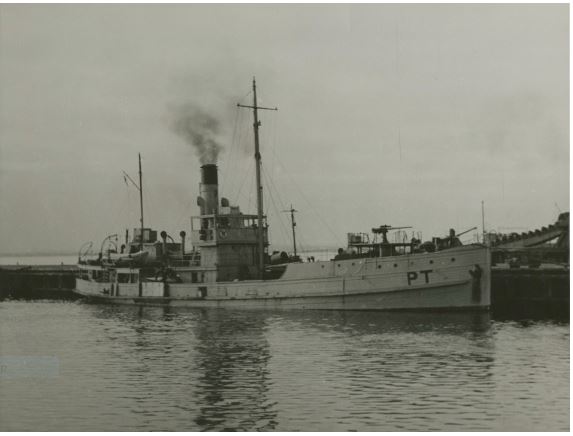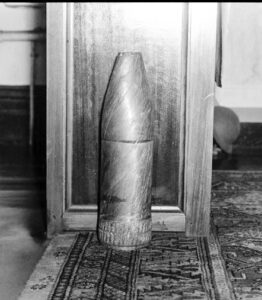- Author
- A.N. Other
- Subjects
- Biographies and personal histories, History - WW2
- Tags
-
- RAN Ships
- None noted.
- Publication
- December 2023 edition of the Naval Historical Review (all rights reserved)
Introduction
When my wife first went to work at West Pennant Hills Public School in the early 1970s she met Thelma Tame, a slightly older colleague; the two became friends, and have remained so to this day. They speak on the phone and occasionally catch up, and I was recently involved in one of these sessions.
Although knowing Thelma for over half a century I knew nothing of her history. Now aged 97, she remains in good health and is mentally alert. So we became engaged in a conversation about her fascinating early life, mainly at the great New South Wales coal port and steelmaking centre of Newcastle. With the aid of her phenomenal memory and a family tree inscribed in her bible this then is Thelma’s story.
The Beginning
Thelma Jean Caird was born in Newcastle NSW on 5 June 1926 to James and Grace Caird nee Sticpewich. The Caird family hail from the seafaring and industrial centre of Dundee on the brisk east coast of Scotland.
As good Presbyterians, drinking and smoking was not permitted in their household. A scion of the family was Sir James Caird, a successful businessman and philanthropist who donated to Ernest Shackleton’s Antarctic expeditions. When Shackleton’s ship Endurance became trapped in ice they escaped in the ship’s whaleboat which was named James Caird. Their eventual salvation became a story of legend captured by the Australian ship’s photographer Frank Hurley.
Clan Caird
Thelma’s father James Caird, born in Dundee on 8 November 1887, migrated (which most likely means he worked his passage in a ship) to Australia in the early 1900s and settled in Newcastle where he found work, firstly on the wharves and later with the newly established Broken Hill Propriety (BHP) steel works. As a single man he enlisted in the 35th Battalion of the AIF on 15 January 1916. The locally recruited 35th were proudly known as ‘Newcastle’s Own’. After initial training they embarked in the troopship Benalla with 33 officers and 1592 other ranks sailing from Sydney on 1 May 1916 via Capetown and arriving in England on 4 July 1916. With the war at an intense stage they soon found action in France and Flanders. The fierce battles of Amiens, Ypres, Villers-Bretonneux, Passchendaele and the Somme were their battlegrounds until the Armistice in November 1918. The Battalion suffered greatly, with nearly 70% casualties – 581 killed and 1637 wounded. James was twice wounded, being patched up and sent back to the front, this time as a corporal. His last wounds were through mustard gas which burnt his legs; for the rest of his life they never fully healed and from time to time the skin would peel off.

James was lucky enough to return to work with BHP. He met Grace Sticpewich, who had lost her fiancée in the war and was now in her early 30s. They married in 1924 and set up house in the central suburb of Cooks Hill. Thelma was an only child and was doted upon. At five years of age she went to Cooks Hill Public School and remained at the same school until she reached her 14th birthday when it was time to leave. In those days only the privileged few went to a high school, technical college or a teachers training college; university was something for the elite. Thelma went to work for the Packer family’s Consolidated Press (publishers of the Daily Telegraph and Women’s Weekly) at their Watt Street offices in central Newcastle. Her mother also paid for the youngster to attend secretarial college where she learned shorthand and typing, honing her secretarial skills.
Watt Street Admirals
Watt Street (originally High Street) was one of the main thoroughfares leading from the Central Business District to the Hunter River wharves. Here shipping companies and merchants handling vast cargoes of coal exports had their offices. These were known as the ‘Watt Street Admirals’ and principal amongst them was the Adelaide Steamship Company. Thelma can still recite the names of their major ships.
Clan Sticpewich
This unusual family name came from Austria where Nicholas Sticpewich was born in 1838, in what is now part of northern Italy. His young life was one of turmoil where he took part in various wars from those seeking independence from the Austrian Empire to the Crimean War where he was employed by the British Secret Service. In 1858 he landed in Melbourne where he married a local girl, Sarah Lang. Seven years later they came to Newcastle and settled at Bullock Island, later known as Carrington. Here he recalls taking ballast from ships and scattering it near the foreshore. In Spring all sorts of flowers would bloom from the seeds that were brought ashore in the ballast.
A well-built man, he worked on the wharves and was prominent in the Painters and Dockers Union. Nicholas was also known for his linguistic skills, speaking seven languages, and for many years he assisted at the Newcastle Law Courts as an interpreter. Upon his death in 1920 at age 92 his legacy was a large family of five sons, two daughters and 25 grandchildren.
Another of Thelma’s grandparents that she remembers was Rebecca Sills. The Sills came from Sheerness in Kent and how they arrived at Newcastle remains a mystery. But they must have prospered as Edward Sills was proprietor of the Old Naval Brigade Hotel during the 1870-1880s in Watt Street, adjacent to the Naval Brigade depot and training ground which was active between 1863 and 1902.

One of the Sticpewich granddaughters was Thelma’s mother Grace, born at Carrington on 17 February 1889; she became a nurse and during the war worked at Stockton Hospital. Another grandchild, William Hector (Bill) Sticpewich, also born at Carrington on 4 June 1908, was a successful professional speedway rider before the war, performing in Europe and at Sydney’s Royal Easter Shows. He enlisted with the 2/AIF on 19 June 1940 and his promotion was rapid. Bill served in Singapore where in 1942 he became a Japanese POW serving in the horrific Sandakan camp in North Borneo, where over 1400 Australian prisoners perished in death marches, with only six survivors.
Amongst these was Warrant Officer Bill Sticpewich who recovered and remained in the Army as a witness during War Crimes Commission hearings. He reached the rank of Major and was awarded an MBE. To many Bill was a war hero, but some controversy arises from allegations of preferential treatment through collaboration with his captors. It is possibly noteworthy that his service records are withheld from public access.
The War comes to Newcastle
When Thelma was aged 13 she recalls sitting in front of the radio with her grandmother, Rebecca, hearing the news that war had broken out between Britain and Germany and as such Australia was also at war. While preparations had been underway for some time this placed a new sense of urgency on developments. There was an absence of young men with most enlisted in the armed forces, the beaches were blocked off with barbed wire, and at night blackouts applied.
Now at work, Thelma was aware that the navy had opened offices on the ground floor of the Customs House, confusingly known as HMAS Penguin (III); this was later changed to HMAS Maitland (the name Newcastle being already used by the RN). A minefield had been established off the entrance to the harbour and a port signal station was built at Nobbys Head to monitor the control of shipping into and out of the harbour.
There was a secondary naval office in the Consolidated Press building from where a young sailor made daily trips taking messages. This handsome young man was Ordinary Seaman Frank Meyer who came from Sydney and was two years older than Thelma.
Frank had just joined his first ship, not some dashing new destroyer, but the ungainly coal burning trawler HMAS Goolgwai. She formed part of a minesweeping flotilla of seven vessels based at Newcastle. These small coasters and fishing vessels had been requisitioned for war service and crewed with RANR crews. The ships had large identification letters painted on their bows – Goolgwai was GG and Paterson PT, etc. Later Frank was posted to HMAS Manoora(previously an Adelaide Steamship liner and now an armed merchant cruiser) and then to New Guinea. While they wrote to one another during the whole of the war years the relationship petered out on his return as they found themselves completely changed by their experiences.
On 30 May 1942 a Japanese floatplane launched from the large submarine I-21 overflew Sydney and Newcastle looking for potential targets. The well- documented submarine attack on Sydney occurred on the night of 30 May/1 June 1942. Not so well known was that on the night of 3 June when off Norah Head I-24 shelled the coastal steamer Age but she escaped and reached Newcastle the next day. On the same night, not so lucky, was the BHP ship Iron Chieftain on passage from Newcastle to Whyalla with a cargo of coking coal; she was torpedoed and sunk with a loss of 12 lives. On 4 June another BHP ship Iron Crown, when off Gabo Island northbound with a cargo of iron ore, was torpedoed and sunk by I-27 with the loss of 37 lives.

A few days were to pass until at 2.15 am on 8 June when about 9 km off the coast I‑21 shelled Newcastle. In total 34 x 5.5-inch calibre shells, which included eight star shells, fell on the city which surprisingly only did minor damage and there were no casualties. In return the big guns at Fort Scratchley got away four rounds. Thelma recalls the noise and alarm with people rushing out into the streets to witness the spectacle; she recalls houses damaged at Parnell Place and her father telling of a shell landing at the Rylands wire rope works, and another at the steelworks which did not explode.
On 14 June 1942 there was an alleged sighting of a periscope off Newcastle resulting in shots again being fired from Fort Scratchley and a full-scale naval search and the dropping of small depth charges but nothing was found.
This turmoil caused panic amongst a population under attack from an unseen enemy. What would happen next – was this the start of an invasion? On 22 June 1942 Thelma’s father, now in his 55th year, took action and re-enlisted as a Sergeant posted to a detachment responsible for the defence of the steelworks.
The Japanese submarine offensive continued with another boat I-175 sent south on patrol. On the night of 22 July 1942 off Newcastle she torpedoed the steamer Allara taking sugar from Cairns to Sydney. She was badly damaged with five men killed and another nine injured, but the vessel remained afloat and was towed into Newcastle for repairs.
At the strategic level the importance of the Hunter region with its coal supplies and steel manufacturing and port facilities was acknowledged and coastal batteries were installed. An air base was first established at Rathmines on Lake Macquarie in December 1939 with a flight of Seagull (Walrus) seaplanes, these were later joined by Kingfisher floatplanes and from 1942 by the larger Catalina flying boats. Another RAAF fighter base under construction at Williamtown commissioned in February 1941.
Further afield at Nelson Bay the amphibious landing training facility HMAS Assault commissioned in September 1942.

The area became a hive of activity, especially for United States servicemen, with 20,000 passing through the region for training before entering the Pacific to battle against the Japanese. The Americans built the road from Newcastle to Nelson Bay. Thelma recalls the Newcastle department store Bebarfalds being taken over by the American Red Cross as a Services Club and entertainment centre. Here the great film star and comedian Bob Hope, accompanied by the songstress Frances Langford, entertained troops. The Bob Hope party literally made quite a splash as their Catalina flying boat developed engine failure and made a forced landing at Camden Haven about 200 km north of Newcastle, fortunately there were no injuries.
A Leading Lady
Thelma enjoyed the theatre and as a youngster had singing and piano lessons. In her teenage years she auditioned for the Newcastle Amateur Operatic Society and with a petite figure, fine complexion and a good vocal range as a coloratura soprano she quickly rose from the chorus to become a leading lady. Concerts were given throughout the region including the RAAF bases at Rathmines and Williamtown.
Coincidently, another coloratura soprano of Presbyterian Scottish descent was born in Sydney in the same year as Thelma. After marrying her singing coach, she later become the internationally acclaimed operatic star Dame Joan Sutherland.
Thelma also found a new friend from the Operatic Society, Donald (Don) Tame. His family was well-known locally and Don had recently qualified as an architect. The two started ‘going out’ and in 1952 they married. Don’s work took him to Sydney where they moved to a rental property at Abbotsford, and to support Thelma’s mother and father, they purchased a small house at nearby Rodd Point.
Thelma and Don had two children, Karen and Randall, and later moved to a new house in the then outer suburb of West Pennant Hills, where Thelma lives to this day. Unfortunately, the marriage did not last and Don found another partner, with Thelma staying on her own, but she remains a charming Leading Lady.




